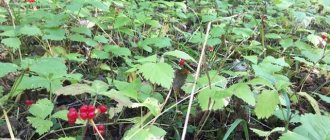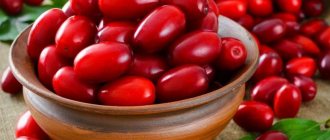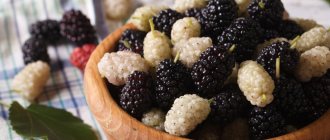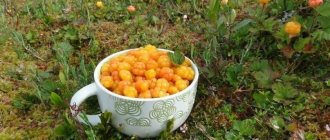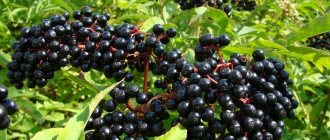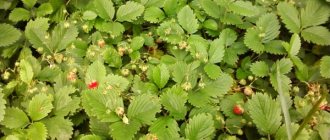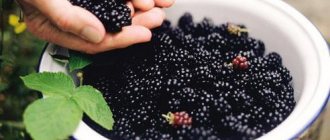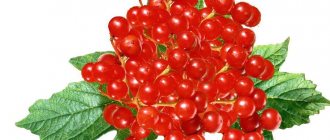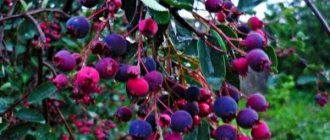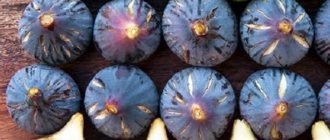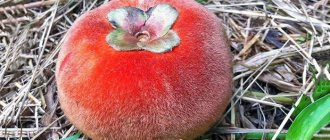How to distinguish edible honeysuckle from inedible ones
Many people have known the taste of honeysuckle since childhood. This is a multi-species plant, so it can be edible or inedible. Both types are used in gardening. Edible species include: Altai, Kamchatka, Turchaninova and others. All of them are presented in the form of bushes. Inedible species may also be shrubs or vines (or other forms).
We recommend reading: Blueberries: health benefits and harms, calorie content, composition
How to distinguish:
- Edible has blue-blue berries with a pronounced waxy coating. The fruits have a spindle-shaped, oval, cylindrical shape. They have a good taste, for example, Kamchatka without bitterness.
- Inedible has small, round fruits with a short stalk, black, red or orange in color. The fruits are poisonous. Such berries are actively used in the field of ornamental gardening: Tatarian, ordinary, Maaka and others. They are also commonly called “wolfberry”.
What are the benefits of honeysuckle for the human body?
This is a common plant in which each part has a lot of beneficial properties. In folk medicine, garden honeysuckle has been used since ancient times to prepare various drinks, decoctions, and infusions that help the cardiovascular, genitourinary, and digestive systems. Fruits, branches, bark, flowers, leaves are useful.
Used for the treatment and prevention of various diseases. The healing properties of honeysuckle are known to many - it helps with heart disease, colds, and digestive problems. Has the following beneficial effects:
- Helps remove harmful substances and toxins from the body.
- Normalization of blood pressure, improvement of heart muscle function.
- Positive effect on the functioning of brain structures.
- Increasing the body's resistance to penetration and development of infectious lesions.
- Eliminate headaches.
- Helps with metabolic processes and digestion.
- Reducing the likelihood of atherosclerotic plaques and blood clots.
The berries will be useful for diabetes, high blood pressure, colds, infectious diseases, and high cholesterol.
It gains its beneficial properties for men and women in a very short time, so it is usually collected in early to mid-June, especially in the southern regions.
For men
The benefits of honeysuckle for men are beyond doubt, because it is rich in vitamins A, B, C, and minerals. It also contains amino acids, pectins, and glycosides. It is often recommended for men over 40 who suffer from hair loss.
It will also be useful for diabetics, since the berries have a positive effect on metabolic processes and are low in calories. The composition also includes pectins, which help with irritated gastric mucosa during the digestion of heavy foods and in cases of poisoning. You can also use honeysuckle to normalize blood pressure.
For women
Honeysuckle berries have particular benefits for women. The berries contain antioxidants that slow down the aging process of cells and improve the condition of the skin. If you eat them periodically, you can achieve overall health of the body, as well as preserve beauty longer. The benefits of honeysuckle berries are enhanced if consumed fresh.
Advice! Honeysuckle is also beneficial for the female figure, so it is often recommended for those who want to lose weight. The reason for this is the acceleration of metabolism and the low calorie content of berries.
During pregnancy
The benefits of honeysuckle during pregnancy are due to its composition. Its positive properties allow:
- Reduce the likelihood of edema formation.
- Improve and stabilize the functioning of the cardiovascular system.
- Eliminate the deficiency of beneficial microorganisms and vitamins in the body of a pregnant woman.
To do this, you need to eat several honeysuckle berries on an empty stomach before each meal.
Nursing mother
Harm to honeysuckle during breastfeeding can only occur in one case - if the nursing mother eats the berries in the first months of the child's life. Doctors recommend starting to use these fruits with beneficial properties six months after the birth of the baby.
The mother should add them to her diet gradually, a few berries at a time, monitoring the baby’s reaction. In the absence of allergies, stomach problems and other unpleasant manifestations, honeysuckle can be eaten on an ongoing basis. In this case, it will not cause any harm to the mother and child - only benefit.
Benefits of honeysuckle for men
The fruit contains a unique substance “selenium”, which is responsible for the normal functioning of the male reproductive system and improves sperm production.
With the help of berries, you can quickly recover after surgery or long-term drug treatment.
With regular consumption of the fruits of the bush, men will be able to prevent hair loss. Berries help improve metabolism. And the pectins contained in berries protect the gastric mucosa from the negative effects of food.
Honeysuckle helps improve liver health and is an excellent tonic food that normalizes blood pressure.
Can honeysuckle be consumed by children and at what age?
The optimal age to give honeysuckle to a child for the first time is 1–1.5 years. You need to start with a few drops of juice or compote. During the first week, the portion can be increased to 20–30 ml, after a month – to 50–70 ml. If the child accepts the berry well, then you can make a puree from it.
Older children can eat honeysuckle berries, but not in large quantities - 1-2 tsp. at a time. They will be useful for schoolchildren and older preschoolers.
In some cases, honeysuckle can be harmful, since after its use there is a possibility of the following:
- hives;
- high temperature;
- constipation or diarrhea;
- increased irritability, tearfulness;
- drowsiness.
Important! If you have such symptoms, it is better to avoid eating berries.
Honeysuckle contains trace elements in huge quantities, so the berries are useful for adults and children.
The benefits of honeysuckle for weight loss
Honeysuckle cannot harm your figure because it is low in calories and is recommended for use by all those who want to lose weight. When consumed, food absorption improves, which leads to a decrease in appetite. The benefits of honeysuckle fruit drink are especially significant.
It also has a pronounced diuretic property, so excess fluid is quickly removed from the body. A sample menu for those who want to lose weight with honeysuckle might look like this:
We recommend reading: Tea with thyme: beneficial properties and contraindications
- Breakfast: berries with cottage cheese (0% fat), low-fat sour cream or natural yogurt.
- Second breakfast: honeysuckle leaf tea and a small piece of cheese.
- Lunch: vegetable soup, salad with boiled meat or fish and fresh vegetables.
- Afternoon snack: 100–150 g of berries. You can season it with low-fat sour cream, natural yogurt, kefir.
- Dinner: buckwheat or rice porridge with berries, apple or pear.
- Before bed: 1 tbsp. kefir
Recommended reading: Benefits of milk tea
Benefits of honeysuckle for women
The fruits of the bush are recommended for consumption during menopause, when mood swings are constantly observed, and short temper often manifests itself. They help cope with stomach disorders and normalize stomach acidity.
Honeysuckle has a choleretic and diuretic effect, removes excess fluid, and therefore prevents the appearance of edema. The berries are recommended for consumption by people who often have nosebleeds; they help reduce blood pressure and improve the functioning of the stomach.
Honeysuckle for diabetes and pancreatitis
The right solution for diabetics is to introduce fresh berries, fruits and vegetables with beneficial properties, vitamins and microelements into their diet. Accepted berries include honeysuckle. Its benefits for diabetics are as follows:
- Normalization of blood pressure.
- Reducing blood cholesterol levels.
- Improves digestion, helps in getting rid of extra pounds.
With pancreatitis, especially during exacerbation, consumption of honeysuckle can cause serious harm.
Attention! The berries contain large quantities of organic acids, which enhance the synthesis of enzymes, which has a positive effect on the development of inflammation.
Excessive consumption of berries can trigger fermentation processes in the intestines.
Beneficial features
In terms of the presence of ascorbic acid, edible honeysuckle berries are on a par with strawberries or lemon. The further north the shrub grows, the more vitamin C it contains. Southern specimens have more sugars, which are represented by fructose and glucose.
Betaine, a glycine derivative, normalizes malfunctions in the body caused by vitamin B12 deficiency.
Folic acid, vitamins C and B6, P (rutin and quercetin) are necessary for the immune system. Participate in hematopoiesis.
Anthocyanins, which give color to fruits, act as powerful antioxidants and suppress the oxidative effects of free radicals. They have anti-cancer and anti-inflammatory properties.
Along with other antioxidant compounds, they prevent the risk of cancer cells. Prevent premature aging.
Vitamin A is necessary to prevent the development of degenerative changes in the retina. Preserves vision in the dark, reduces inflammation.
Rutin is a vitamin that is needed to strengthen the walls of blood vessels. Organic acids help maintain normal acid-base balance in the body.
The presence of potassium and sodium regulates the amount of fluid in tissues. Magnesium and B vitamins normalize the functioning of the nervous system. Necessary for the normal functioning of the brain.
Tannins and pectins regulate the functioning of the digestive system. Dietary fiber, along with pectin compounds, binds toxic substances in the intestines and removes them from the body.
Traditional medicine recipes with honeysuckle
Experts speak differently about the benefits and harms, but in folk medicine this plant is actively used to treat a sore throat, improve memory, with vegetative-vascular dystonia, as a diuretic, and for high blood pressure. Recipes may be as follows.
For a sore throat:
- Pour 250 ml of boiling water over 5–10 honeysuckle leaves.
- Let it brew for 15–20 minutes.
- Bring the broth to a boil, turn off the gas.
- Allow to cool to room temperature.
- Use only for gargling, drinking is not recommended.
To improve memory and for VSD:
- Take 2 tbsp. l. dried berries.
- Pour 1 tbsp. boiling water
- Keep in a water bath for 20–30 minutes.
- Leave for 1–2 hours.
- Use once or twice.
As a diuretic:
- Take 2 tbsp. l. dried honeysuckle bark.
- Pour them with 1 tbsp. boiling water
- Keep in a water bath for 20–25 minutes.
- Let it brew for 30–40 minutes.
- Take 1 tbsp. l. three times a day before meals.
Infusion of honeysuckle berries
The medicinal properties of honeysuckle are known to many - it is a plant rich in vitamins and microelements, which has very tasty berries. To prepare you need to take:
- 300 g honey;
- 400 g berries;
- 2 liters of vodka.
The preparation of the infusion is carried out according to the following scheme:
- First you need to prepare the berries: wash, remove debris, spoiled fruits, dry on a paper towel.
- Then you need to grind it in a blender, mixer or any other means at hand.
- The finished puree must be transferred to a jar, add all the honey and vodka.
- Shake the jar and place it in a dark place at room temperature.
- The mixture should infuse for several weeks.
- After 3-4 weeks, the infusion should be filtered and passed through several layers of medical gauze.
- The finished drink should be bottled.
- You can use it a little at a time for 4-5 years.
Honeysuckle juice
To prepare honeysuckle juice with beneficial properties, you need to take ripe berries, squeeze the juice out of them using any press, mix with water in a 1:1 ratio. To make the juice as healthy and tasty as possible, it is recommended to keep it in a water bath for 10–20 minutes.
Then the finished drink should be strained and cooled to room temperature. There is no need to put it in the refrigerator. This approach to preparation will allow you to preserve all the healing properties.
To speed up the process, you can use a juicer.
Alcohol tincture of honeysuckle
Alcohol tinctures based on honeysuckle are slightly bitter, but have a pleasant aroma. If you consume the ready-made drink in reasonable quantities, it will be beneficial for the human body: it will improve digestion, strengthen the immune system, and help in the fight against colds.
The following ingredients are needed:
- 300 g honeysuckle berries.
- 250 ml water.
- 150 g sugar.
- 1 liter of vodka.
Preparation is as follows:
- Rinse the berries, crush them with a press or your hands, pour the resulting puree into a jar, add vodka, and stir.
- Close the jar with a lid, leave for a week in a dark place, shaking occasionally.
- After 7 days, mix water and sugar in a saucepan, bring to a boil, cook over low heat for several minutes, removing the white foam. Cool the resulting syrup to 25–30 °C.
- Strain the finished tincture through cheesecloth, add syrup to it, close the jar with a lid and leave for another week.
- The drink can be bottled for easy storage.
Honeysuckle tea
To prepare vitamin tea from honeysuckle with beneficial properties, you need to take:
- 2 tbsp. l. berries;
- a few honeysuckle leaves;
- oregano, thyme, mint (to taste);
- 1 liter of boiling water.
All ingredients must be mixed in a kettle or thermos and allowed to brew for 5–10 minutes. You should drink it like a simple herbal tea - there are no special rules.
Use in folk medicine
Honeysuckle is actively used as a home doctor by adherents of traditional medicine. The plant can not only contribute to recovery, but also cause harm in case of illness.
For diabetes and pancreatitis, the plant contains a high concentration of organic acids that negatively affect the affected pancreas. This leads to an exacerbation of pancreatitis, so with this disease it is prohibited.
For diabetics, on the contrary, doctors recommend not to neglect this tasty addition to their usual diet. Unsweetened compotes, teas, juice, fresh berries contribute to:
- cholesterol removal;
- blood pressure stabilization;
- improving metabolism, losing weight.
In case of liver diseases, inflammatory processes in the liver and gall bladder are accompanied by pain and fever. To reduce fever, alleviate suffering, and relieve inflammation, you need to eat fruits or drink a hot drink every day.
To prepare, add 50 g of pureed berries to freshly brewed black tea and leave for 10 minutes. You need to drink slowly, in small sips.
For low blood pressure The product is useful for normal and high blood pressure. If systolic pressure is less than 120 mm Hg, and diastolic pressure is 80 mm Hg, honeysuckle will provoke a sharp drop in readings and will noticeably worsen your well-being.
Blue honeysuckle flowers
For the treatment of hypertension If the blood pressure is elevated and the patient is committed to long-term treatment, a simple method of lowering blood pressure is suitable:
- Dry or purchase the fruits.
- Pour 4 tbsp into a thermos. berries
- Pour 1 liter of boiling water.
- Leave for 4-5 hours.
The product is suitable for the treatment of atherosclerosis, you need to take 2 tbsp. l. three times a day for 2-3 months.
In chronic cystitis, inflammation of the bladder wall is characterized by a frequent urge to urinate, accompanied by pain.
An alcohol infusion with an anti-inflammatory effect will help to cope with the problem:
- 2 tbsp. Dry and chop honeysuckle flowers and leaves;
- pour 150 ml of alcohol;
- leave for 3 days.
The medicine should be taken 3 times a day after meals, 15 drops diluted with water.
For skin diseases, crushed leaves of the plant will have a bactericidal effect. They are ground into powder, which is sprinkled on festering wounds, lichen spots, and cuts.
Berry juice has a healing effect. They soak gauze and make compresses or wipes up to 10 times a day.
For psoriasis, honeysuckle oil is applied to the affected areas of the skin. It is heated in a water bath, then slowly rubbed in. After half an hour, wash it off. Repeat 2-4 times a day, depending on the severity of the disease.
For stomach ulcers Opinions of supporters of traditional medicine regarding the use of honeysuckle for the treatment of gastric and duodenal ulcers differ. Some believe that the anti-inflammatory, regenerative properties of the product will help cure the disease.
Others are confident that such therapy will worsen the patient’s condition. The fruits do contain large amounts of ascorbic acid, the use of which should be avoided when treating ulcers. Therefore, stick to the norm of 2-3 teaspoons per day and everything will be fine.
For diarrhea: Poisoning, side effects of medications, traveler's diarrhea, nervous diarrhea - all this causes discomfort. The bark and branches of the bush have fastening properties. Tannins have an astringent effect and eliminate the problem in a short time.
To prepare the medicine you need:
- Pour 200 g of bark and small branches with 1 liter of water.
- Boil for 20 minutes over low heat.
- Cool.
Drink 50 ml of decoction three times a day.
For edemaSwelling serves as a signal to check the kidneys. In case of urinary retention, as well as swelling of other origins, take diuretics.
A tincture of fresh honeysuckle leaves has this effect:
- Pour 250 ml of boiling water into 5 tbsp. crushed leaves;
- Leave for 4 hours, strain.
Drink 3 tbsp daily before meals. spoons 2 times a day.
For colds To reduce the temperature during a cold, use a fruit drink:
- Grind 100 g of berries into a paste;
- pour ½ liter of hot boiled water 70 degrees;
- leave for 15 minutes.
Drink 1 glass warm twice a day before meals.
Benefits and uses of honeysuckle leaves
Honeysuckle leaves are edible. They have long been used to make decoctions and infusions, teas, compotes, and fruit drinks. In its pure form, the leaves can be used as an antimicrobial, anti-inflammatory and diuretic. Harvesting is carried out during flowering. Dry the leaves in the shade outdoors. You can make a healthy drink from them for every day.
One of the most popular recipes from honeysuckle leaves is the following:
- Pour 1/2 tsp into the teapot. dried leaves or add two fresh ones.
- Pour 250 ml of boiled water, slightly cooled.
- Leave to infuse for 20–30 minutes.
One serving is enough for the whole day. You need to use 1/3 tbsp. three times a day before meals.
Medicinal properties of honeysuckle
Edible honeysuckle brings tangible benefits to the body and does not cause any harm to health. If you have your own plot of land, then shrubs can decorate it. In addition to being decorative, it is very pleasant to enjoy early juicy fruits.
Beneficial properties of honeysuckle berries and contraindications
The benefits of honeysuckle berries are great, but the harm lies only in excessive consumption of the fruit. A juice with wonderful properties is squeezed out of the berries: it easily removes lichen and treats skin diseases. Drink juice 1 tbsp. l. three times a day.
With such a powerful medicine, anything can be done
Eating fresh berries promotes overall health of the body and helps replenish the lack of important substances. A healing decoction is made from the berries for washing the eyes, mouth, and throat. The large amount of vitamin C makes the fruit an excellent remedy against scurvy. Even dried fruits have their own benefits - they are a natural antibiotic.
What are the benefits of honeysuckle flowers, bark, leaves and shoots for the body?
For kidney diseases, a decoction of honeysuckle branches is especially useful; at the same time, it increases the extinct appetite. The leaves are used to make a medicinal decoction against throat diseases, which is popular among people. The flowers are infused in boiling water and used to wash the eyes. Honeysuckle branches steamed in a bath provide relief from attacks of rheumatism.
Brewed bark relieves headaches
A course of decoction of crushed shrub bark perfectly fights dropsy. The plant extract is effective against eczema and psoriasis. Korean scientists studied the properties of flowers as medicinal raw materials. They include honeysuckle in compound medicines for many serious diseases, such as tuberculosis, lung abscess, and dysentery.
A decoction of branches is drunk as a diuretic, which also removes swelling. To prepare an infusion from the leaves, take 3 tbsp. l. crushed dry raw materials and a glass of water, boil everything for 3 minutes and leave to infuse for 2 hours.
What are the benefits of honeysuckle bark and branches?
The bark has long been used in folk medicine for colitis, swelling, dropsy, as well as for treating wounds, burns, and treating inflammation in the throat. A decoction is often prepared from the branches of the plant - it is a natural and very useful diuretic. The recipe is as follows:
- You need to take 1 tsp. dried branches.
- Pour in 250 ml of water.
- Boil the mixture for 25–35 minutes.
- Finally, cool and strain through several layers of gauze.
- You need to take the product 1 s at a time. l. 3–4 times a day.
Beneficial properties of honeysuckle flowers
The flowers are also edible, so they cannot cause any harm. Their beneficial properties are used in folk medicine to reduce body temperature, remove toxins and other harmful substances from the body, and eliminate the inflammatory process of various localizations. From them you can prepare a healing infusion that helps with colds and pneumonia:
- You need to take 1 tbsp. l. dried flowers.
- Pour 1 tbsp. boiling water, let it brew for 1 hour, strain through cheesecloth.
- The infusion should be taken during illness, ½ tbsp. twice a day, every 12 hours.
Honeysuckle: health benefits and harms
The plant has a beneficial effect on the entire body. Due to the healing properties of all parts of the bush, honeysuckle is widely used in folk medicine. It is used for the treatment and prevention of various ailments.
Honeysuckle is used to treat diseases of internal organs
- Honeysuckle is an excellent antipyretic. It reduces fever well, relieves coughing attacks, and removes foci of inflammation in the respiratory tract.
- The berries are taken as a preventive measure against flu and colds.
- It has a beneficial effect on atherosclerosis, stabilizes blood pressure, fights headaches, and is useful for various problems of the cardiovascular system.
- Improves the functioning of the liver and gall bladder, and is used both for the treatment and prevention of diseases of the gastrointestinal tract.
- Strengthens the immune system, prevents premature aging, helps in removing toxins, heavy metal salts, and prevents the formation of cancer cells.
- Recommended for diabetes and other metabolic disorders.
- Indicated for women during pregnancy and lactation. It can perfectly replace those medications that are prohibited for use in these conditions.
Attention! The consumption of honeysuckle berries by pregnant and lactating women should be in limited quantities, since all its effects have not yet been fully studied. It is recommended to eat them fresh, a little at a time - no more than 2-3 spoons.
Honeysuckle is a very healthy berry with a delicate and pleasant taste. But even she has certain contraindications.
Honeysuckle jam
The main ones:
- children under 5 years of age;
- allergic reactions and rashes on the body.
It is undesirable to eat fresh berries if you have a stomach ulcer or duodenal erosion. For these ailments, it is better to take a decoction of the leaves of the plant.
Advice. You should not pounce on berries, consuming them in large quantities at once. It is better to eat them little by little throughout the entire fruiting period of the plant. This way they will bring much more benefits to the body.
Honeysuckle in home cosmetology
The benefits of honeysuckle are also enormous in the field of home cosmetology. It acts as a basis for creating all kinds of creams and masks. These natural cosmetic products are suitable for all skin types. With their help, the following problems are eliminated:
- Hypovitaminosis.
- Small wrinkles.
- Loss of skin elasticity.
- Presence of spider veins.
- Acne.
- Dysfunction of the sebaceous glands.
- High dryness of the skin.
For facial skin
Honeysuckle is usually used to make anti-aging face masks. It is not recommended to use them if you have skin diseases of unknown etiology or are intolerant to the plant. In this case, significant damage will be caused to the skin.
It is recommended to take a closer look at the following recipe. Ingredients used:
- 100 g of fresh berries;
- 50 g sour cream;
- 20 g honey.
The mask is prepared as follows:
- Grind the berries in a blender until pureed.
- Mix puree with sour cream and honey.
- Apply the finished mixture to the skin of the face.
- You need to hold it for 15–30 minutes.
- Rinse off with regular running water.
For hair
The beneficial properties allow this plant to be used to strengthen and improve hair growth. This healing remedy is suitable for men and women. The cooking recipe is as follows:
- It is necessary to brew 1 liter of boiling water with 1–2 tbsp. l. crushed dry honeysuckle leaves.
- The mixture should sit for an hour and a half.
- After this, you need to strain it through cheesecloth.
- The hair must first be washed in the usual way, then rinsed with the resulting healing product, wiped a little and allowed to dry.
How honeysuckle is useful for diseases and special conditions
The biggest benefit of honeysuckle for the body is strengthening the immune system. This is a strong blow to spring vitamin deficiency, which will drive away most infections, drive away the flu that is rushing to board and drive away colds. Many will appreciate the benefits of the berry for heartburn, decreased appetite, digestive problems and exhaustion. The effect of the fruit on anemia, atherosclerosis, joints, and vision is noticeable. The product helps you forget about constipation. The antipyretic properties of a decoction of twigs and leaves are valuable.
A useful product growing in your garden
For liver diseases and stomach ulcers
For various problems with the digestive system, the presence of gastritis and ulcers, it is recommended to take any products made from honeysuckle fruits. The berry also cleanses the liver, which is undoubtedly an excellent quality. For cleansing, decoctions, infusions and raw fruits are used.
For skin diseases
The peoples of the North and East have long appreciated the ability of honeysuckle to treat skin diseases. The natural antiseptic is beneficial both when taken orally and when the affected areas are lubricated with fruit juice.
Skin health is your concern
Beneficial properties of honeysuckle and contraindications for blood pressure
It is important for people suffering from high blood pressure to know whether honeysuckle increases or decreases blood pressure. Eating berry products helps to smoothly reduce blood pressure, while at the same time strengthening the walls of blood vessels. It is recommended to take the fruit if there is a tendency to decrease heart rate, threatening sinus rhythm disturbance.
Honeysuckle during pregnancy
During pregnancy, it is useful to eat a handful of fruits, which replenish the lack of nutrients in the body.
Don't forget to consult your doctor about taking berries during pregnancy.
Honeysuckle will be useful during this period if you are prone to constipation.
Honeysuckle for weight loss
Betaine contained in fruits reduces cholesterol levels, which promotes systematic weight loss. Taking honeysuckle is beneficial due to its high concentration of important substances and vitamins with low calorie content.
The benefits of honeysuckle preparations
The benefits of honeysuckle preparations for the human body are invaluable - the plant helps with colds, heart disease, and respiratory diseases. In different regions of Russia and other countries of the world, various preparations are made from honeysuckle: fruit drinks, juices, jam, wine. Drinks and food containing it can:
- Improve blood counts and increase hemoglobin levels.
- Cleanse the body of waste and toxins, remove excess salts and metals.
- Accelerate recovery processes for colds and serious viral pathologies.
- Improve the functioning of brain structures, cardiovascular system, and digestion.
- Have a beneficial effect on various metabolic processes in the body.
Important! Preparations made from this product will be effective for bronchial diseases, asthma, tuberculosis, because have expectorant properties.
Honeysuckle: beneficial properties for women
- Berries have antioxidant properties. Regular consumption of honeysuckle promotes healing and rejuvenation of the body. Berries prevent the body from aging. What else do women need? They will remain young for a long time.
- Honeysuckle berries have anti-inflammatory properties. This allows them to be used to improve skin health in cosmetology. Japanese scientists have proven that honeysuckle prevents the formation of wrinkles.
- A huge amount of useful vitamins helps with vitamin deficiency. Honeysuckle berries can be consumed by pregnant women as a natural vitamin supplement.
- Speaking about the benefits of honeysuckle for the body of women, one cannot fail to mention its help with cardiovascular diseases. Honeysuckle berries will help solve problems with the heart, blood vessels, and blood pressure.
Possible harm to honeysuckle and contraindications
Honeysuckle can cause significant harm to humans when consumed. But this happens rarely and in certain cases. The following features can be highlighted:
- You should not abuse this remedy, because it can lead to muscle spasms, unpleasant pain in the abdomen, and the development of constipation or diarrhea.
- It is forbidden to eat berries or take folk remedies from honeysuckle if any allergic reactions occur after the first dose. In this case, you should completely refuse further use for any purpose.
Some harm can be caused to pregnant and nursing mothers, so the plant should be introduced into the diet carefully and in minimal portions.
Honeysuckle collection and storage
The ripening of honeysuckle on bushes occurs in stages: first in the upper part, and then in the lower part. Therefore, you can pick berries from late July to mid-August. This is an early ripening product. Therefore, after full ripening for several days, the berries begin to fall off.
Honeysuckle spoils quickly, so it needs to be processed. You can store it in its pure form for only a few days. For long-term storage, the fruits must be dried or frozen, or used immediately for various preparations:
- jelly;
- jam;
- fruit drink;
- compote;
- sherbet.

